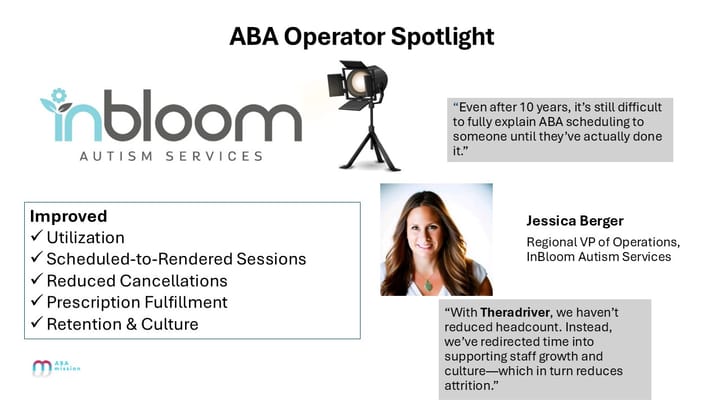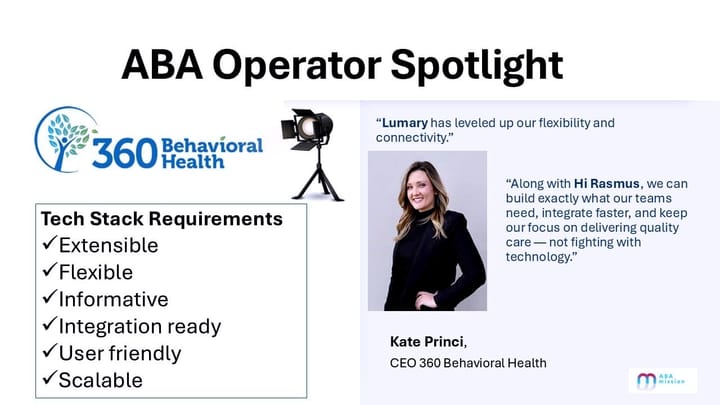Operator Spotlight: Yellow Bus ABA

Family Roots and a Talent-First System for Scaling in New York
Most of my Operator Spotlights focus on the largest ABA providers, because their decisions on technology, staffing, and operations tend to ripple across the entire industry. They have the scale to influence payors, vendors, and workforce norms in ways mid-market providers rarely can.
On occasion, a mid-sized provider grows so quickly and deliberately that it demands attention. Yellow Bus ABA is one of those cases. Their outsized growth caught my eye in the Provider SCUBA data I track each month. I wanted to understand: what systems are driving this acceleration in one of the toughest markets in the country?
What stood out in my conversation with Yellow Bus’ David Parnes is that this family-led organization hasn’t scaled through chance or brute force. They’ve built a system of systems — intentional structures for scheduling, talent, technology, and branding. Each one addresses a New York market constraint, and together they reinforce growth.
Origins: A Family-Led Mission
Yellow Bus began with a clinician’s vision. David Parnes’ mother Estelle Parnes, a professor and lifelong ABA practitioner, wanted to provide intensive early intervention without becoming a “big-box” provider. Her approach emphasized quick starts, efficient care, and shorter service lengths, so more children could access therapy despite limited resources.
When her sons joined the business, the model expanded:
- David’s brother brought real estate and operations expertise, solving for New York’s scarce and costly space.
- David leaned into marketing, business development, and system design, shaping the organization’s growth engine.
This family dynamic created a rare balance: clinical integrity, operational savvy, and business development — working in concert.
The New York Paradox
Scaling in New York is unlike scaling anywhere else:
- Unlimited demand: Thousands of families on waitlists; many commute by train for an hour+ if there’s no local clinic.
- Space scarcity: Apartments are too small for many home sessions, and commercial real estate at $40–$60 per square foot forces providers to maximize every inch.
- Mixed payor economics: Medicaid exists but at low rates; some commercial contracts are viable, others unsustainable.
- Labor pressure: Cost of living is sky-high, making retention difficult without structured compensation and progression.
Yellow Bus has designed systems to turn these constraints into advantages. Here is an overview of how each system addresses one of those constraints.
Constraint 1: A System for Scheduling With Consistency
Most providers manage cancellations like a puzzle, constantly re-arranging hours. Yellow Bus took a different path.
A dedicated back-office scheduling team oversees caseloads and time blocks. Families and staff are offered consistent schedules (e.g., Mon/Wed/Fri 3–6pm), rather than patchwork sessions. With 2–3 daily “rounds” of 25–30 learners per center, every square foot of expensive real estate is maximized.
Here, monday.com serves as the visibility layer. Boards track staff availability, learner assignments, and utilization across centers. Conflicts surface in real time, giving schedulers the tools to keep both families and staff on stable ground.
Constraint 2: A System for Talent as a Pipeline
Retention isn’t treated as an afterthought. Yellow Bus intentionally built career ladders into its operating model:
- Full-time BCBAs provide stability and competitive salaries.
- BTs advance through Levels 1–3, with structured promotions and increasing pay.
- Associate Trainers mentor new hires inside sessions, ensuring competence and confidence from day one.
- Center Leads and Regional Managers offer clear paths into leadership.
BTs can progress into roles earning up to ~$80K/year, unusual in the field. As David, put it....
“If we can show people that they can come into Yellow Bus, do really well, and grow, then we’re not just offering jobs — we’re building careers.”
Monday.com acts as the talent pipeline tracker. Promotions, mentorship activity, and progression milestones are logged as workflows. HR can see who is ready to step up, while staff see visible career pathways. Talent is no longer a bottleneck — it’s a measurable system of growth.
Constraint 3: A System for Employee Engagement as Infrastructure
Employee experience is managed with the same rigor as scheduling. Surveys, recognition, and feedback loops are run through monday.com automations and simple integrations. New-hire cohorts are tagged, sentiment is tracked, and recognition is tied to specific milestones.
Associate Trainers supplement this digital system with hands-on mentorship, embedding in sessions to provide guidance and support. Combined, HR and monday.com ensure no staff member feels abandoned — engagement becomes a trackable, repeatable process, not just a cultural aspiration.
Constraint 4: A System for Branding as a Referral Flywheel
What about families? Yellow Bus doesn’t rely on CRM to chase them. Their branding and community presence already drive the majority of growth:
- Nearly 80% of learners come via self-referrals.
- YouTube videos and social campaigns have reached millions, creating awareness and trust.
- Pediatricians and diagnosticians consistently refer families, creating a compounding network effect.
David explained....
“Most providers treat staff and families as two separate problems. We market just as hard to potential staff as we do to families — because if you don’t have staff, you can’t serve learners.”
With demand this strong, CRM is pointed inward. Monday.com doubles as an internal marketing channel, where HR highlights career ladders, growth stories, and recognition. Staff are constantly reminded that Yellow Bus is a place to build a career, not just take a job.
Reflection: Systems Built for New York
Yellow Bus ABA isn’t scaling on luck. They’ve built a system of systems matched to their market:
- Scheduling discipline that keeps families and staff consistent.
- Career ladders and mentorship that turn jobs into careers.
- A work management platform — anchored in monday.com — that tracks engagement and progression.
- Branding that drives self-referrals, freeing technology to focus inward.
At the core is a family-led leadership team that blends clinical roots, operational focus, and business development.
For providers in dense, high-cost markets, the lesson is clear: growth doesn’t come from chasing every lead — it comes from designing systems that let people thrive.
Want more insights on tech, ops and data? Subscribe here



